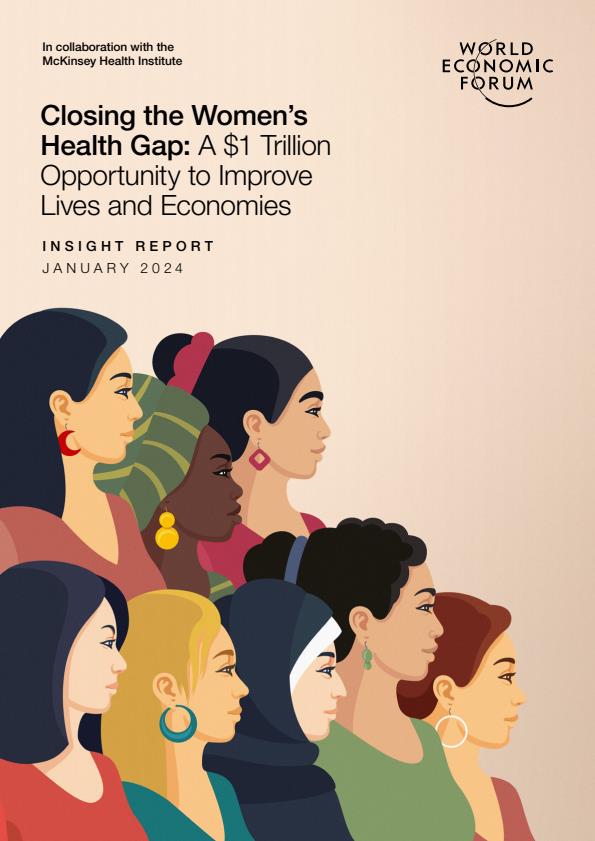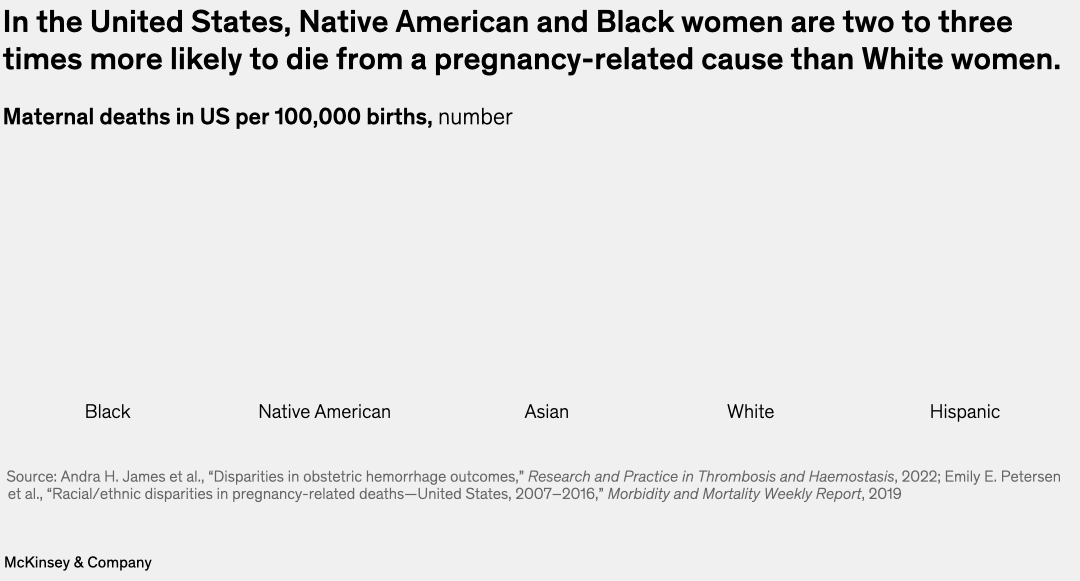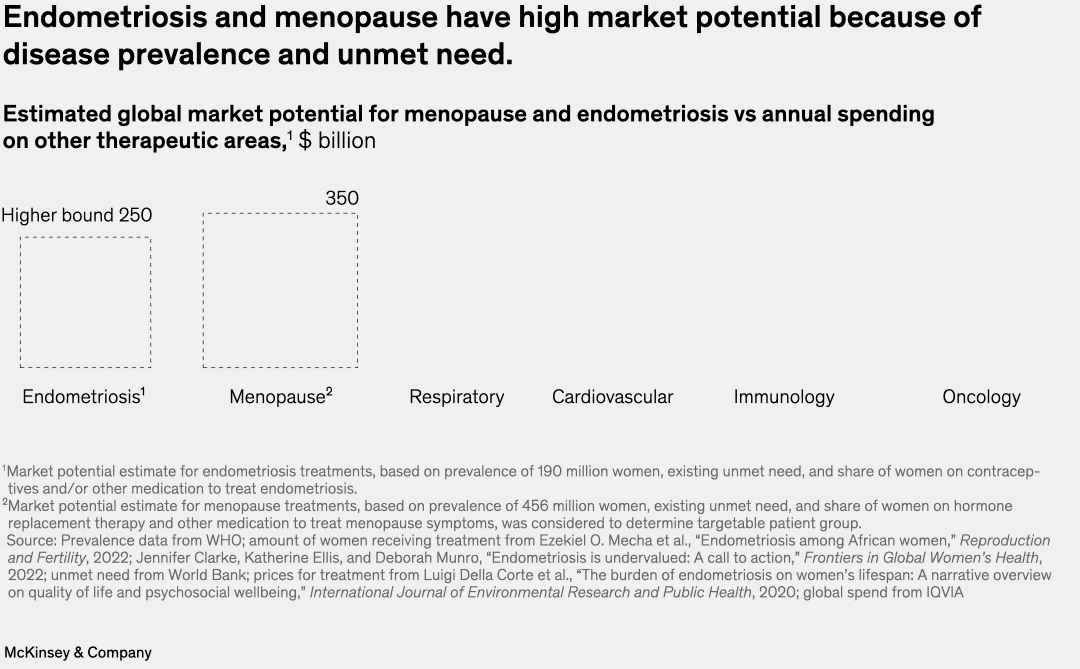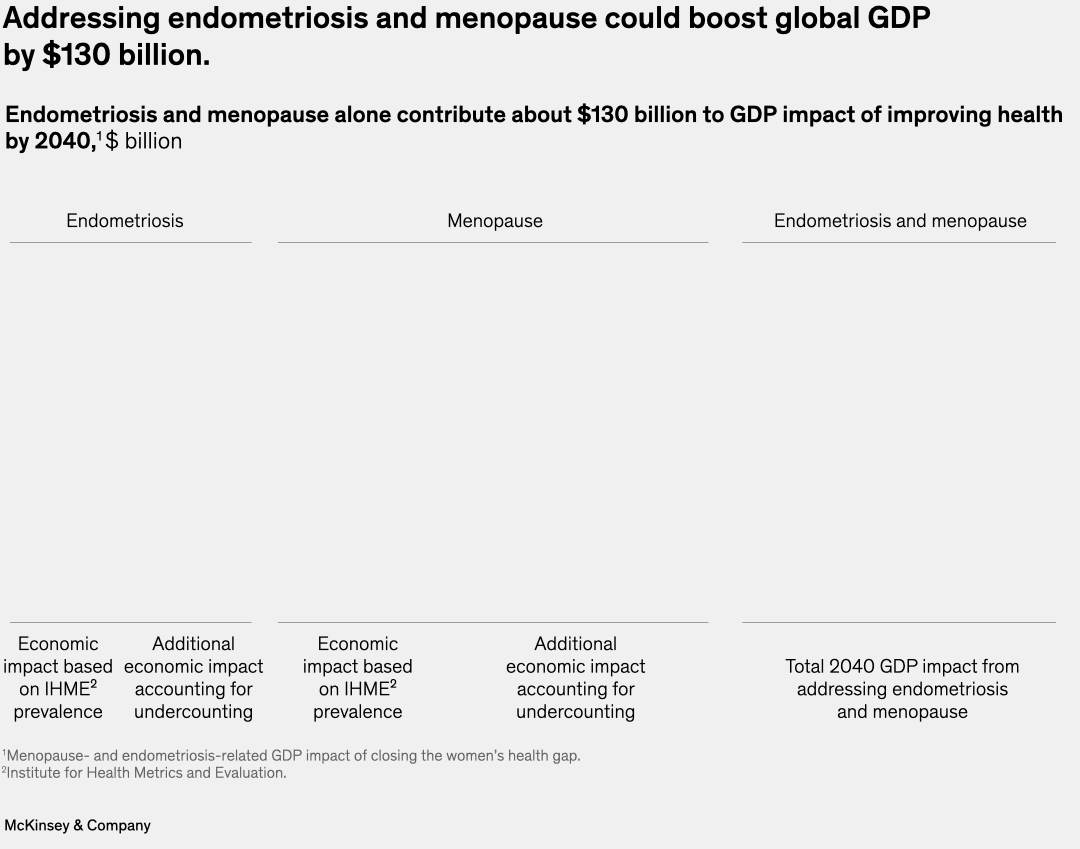Over the past two centuries, the rise in life expectancy—for both men and women—has been a tremendous success story. Global life expectancy increased from 30 years to 73 years between 1800 and 2018.1 But this is not the full picture. Women spend more of their lives in poor health and with degrees of disability (the “health span” rather than the “life span”). A woman will spend an average of nine years in poor health, which affects her ability to be present and/or productive at home, in the workforce, and in the community and reduces her earning potential (see sidebar “Terminology used in this report”).
Building on previous work from the McKinsey Health Institute and the McKinsey Global Institute,2 analysts quantified this health gap in terms of disability-adjusted life years (DALYs)3 and the extent to which this difference results from the structural and systematic barriers women face (see sidebar “Research methodology” ). Addressing the 25 percent more time that women spend in “poor health” relative to men not only would improve the health and lives of millions of women but also could boost the global economy by at least $1 trillion annually by 2040. This estimate is probably conservative, given the historical underreporting and data gaps on women’s health conditions, which undercounts the prevalence and undervalues the health burden of many conditions for women.
Critically, better health is correlated with economic prosperity. The women’s health gap equates to 75 million years of life lost due to poor health or early death per year (Exhibit 1), the equivalent of seven days per woman per year. Addressing the gap could generate the equivalent impact of 137 million women accessing full-time positions by 2040. This has the potential to lift women out of poverty and allow more women to provide for themselves and their families. Addressing the drivers of this gap—namely, lower effectiveness of treatments for women, worse care delivery, and lack of data—would require substantial investment but also reflect new market opportunities.
While improving women’s health has positive economic outcomes, it is foremost an issue of health equity and inclusivity. Addressing the women’s health gap could improve the quality of life for women, as well as creating positive ripples in society, such as improving future generations’ health and boosting healthy aging.

The challenges women face when seeking healthcare play out in multiple different ways and in different diseases and sectors of society. In terms of the potential economic impact of addressing these challenges, all age groups and geographies could benefit, with most of the potential coming from women of working age (Exhibit 2).

Embracing the full definition of women’s health
Women’s health is often simplified to include only sexual and reproductive health (SRH), which meaningfully underrepresents women’s health burden. This report defines women’s health as covering both sex-specific conditions (for example, endometriosis and menopause) and general health conditions that may affect women differently (higher disease burden) or disproportionately (higher prevalence).4
Research shows that SRH and maternal, newborn, and child health (MNCH) account for approximately 5 percent of women’s health burden,5 although this is probably an underestimate (Exhibit 3). An estimated 56 percent of the burden comes from health conditions that are more prevalent and/or manifest differently in women. The remaining 43 percent stems from conditions that do not affect women disproportionately or differently based on current evidence.

Women are most likely to be affected by a sex-specific condition between the ages of 15 and 50. Other conditions occur throughout women’s lives, but nearly half of the health burden affects women in their working years, which often has an impact on their ability to earn money and support themselves and their families (Exhibit 4).

Pregnancy complications can increase risk for chronic illnesses; for example, gestational hypertension can portend chronic hypertension,6 and women who have had gestational diabetes have a 50 percent risk of developing type 2 diabetes seven to ten years after the birth of the child.7 Good maternal health helps the mother and baby, with benefits extending beyond pregnancy and birth.
Health equity encompasses access to the interventions and options that are right for each individual, regardless of their gender, sex, sexual identity, sexual orientation, age, race, ethnicity, religion, disability, education, income level, or any other distinguishing characteristic. For women, this can start with a better understanding of and access to interventions that lead to the best outcomes.
How to read this report
The analysis presented in this report includes an assessment of the health burden associated with the women’s health gap as measured in potential years of healthy life. This health improvement potential was then translated to economic potential, measured as contribution to gross domestic product (GDP). Sections 2 through 4 of this report focus on health improvement potential (measured in DALYs), broken down by three root causes related to disparities in science, data, and care delivery. The economic value of this combined health improvement potential is presented in section 6, where economic impact is measured in terms of additional GDP.
While this report focuses on the potential economic benefits of closing the women’s health gap, there is also a moral imperative to close the women’s health gap and to improve the lives of millions of women worldwide.
1. The role of science in addressing health disparities
Biomedical innovation builds on the basic understanding of science around body function and the cellular and molecular pathways involved in disease development and progression. Historically, men have both led and been the subject of the study of medicine and biology.8 The majority of animal models have been based on male specimens.9 Questions about sex-based differences were rarely investigated or recorded, with the assumption—now known to be false—that there are few important differences in the functioning of organs and systems in men and women beyond reproduction. To understand basic female biology better, fundamentally new research tools should be developed—for example, animal models, computational models, patient avatars and humanized models—that better classify women’s symptoms and manifestations of disease, as opposed to calling those “atypical.”10 This represents a tremendous opportunity for the healthcare and life sciences community to improve the lives of women around the world.
Effectiveness of and access to medical therapies may vary
There are well-known cases where women and men experience important differences in the uptake or effectiveness of a medicine designed and approved for use in both sexes. This is true, for example, for some therapies used in asthma and cardiovascular disease. Analysts looked at 183 of the most widely used interventions across 64 health conditions representing roughly 90 percent of the health burden for women, reviewing more than 650 academic papers, to assess the extent of this phenomenon. Of the interventions studied 50 percent reported sex-disaggregated data. In cases where sex-disaggregated data was available, 64 percent of the interventions studied were found to put women at a disadvantage due to lower efficacy, more limited access, or both, while for men this was the case only for 10 percent of interventions (Exhibit 5).
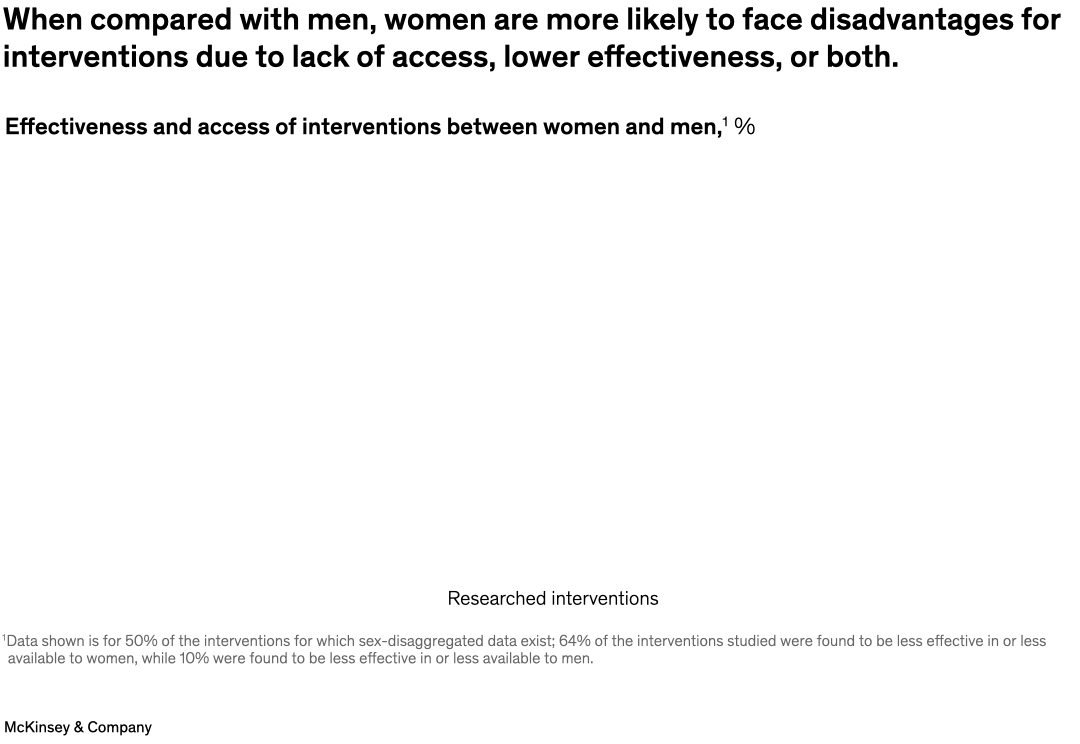
Examples include:
- Asthma is a common respiratory condition affecting men and women at similar prevalence rates. Acute asthma exacerbations present as symptoms such as shortness of breath, wheezing, cough, or chest tightness.11 A mainstay of treatment is inhaler therapy with bronchodilators and corticosteroids, but studies indicate that this treatment is around 20 percentage points less effective in reducing exacerbations in women than in men.12
- Cardiovascular and cerebrovascular disease—particularly ischemic heart disease and stroke—is the biggest single contributor to disease burden globally for both men and women, accounting for 16 percent of DALYs globally for men and 14 percent for women.13 One German study found that, despite identical technical success of a percutaneous cardiac intervention for men and women, the age-adjusted risk of death or of cardiac events was 20 percent higher in women than in men.14
Research in women’s health primarily focuses on diseases with high mortality, overlooking diseases leading to disability
One way to assess research priorities is through pipeline assets. There is up to a tenfold higher volume of new therapies in development for some of the most common women’s cancers compared with debilitating gynecological conditions (Exhibit 6). One possible reason is the higher mortality rate of oncologic conditions. The solution is not to trim cancer funding, but to recognize the possibilities for advances in research related to other women’s health conditions—in particular, menopause, premenstrual syndrome, endometriosis, and polycystic ovary syndrome.
Additionally, maternal conditions should receive more attention. Compared with women-specific cancers, they contribute a similar share to overall suffering among women, but there is a large discrepancy in the pipeline of therapies in development. For example, even though postpartum hemorrhage (PPH) is the leading direct preventable cause of maternal mortality in low-income countries (LICs) and low- or middle-income countries (LMICs), only two new medicines shown to be effective in PPH management have been developed over the past 30 years.15
In all, when tackling women’s health, the solution is not to divide more slices of one pie: it’s to make more pie.
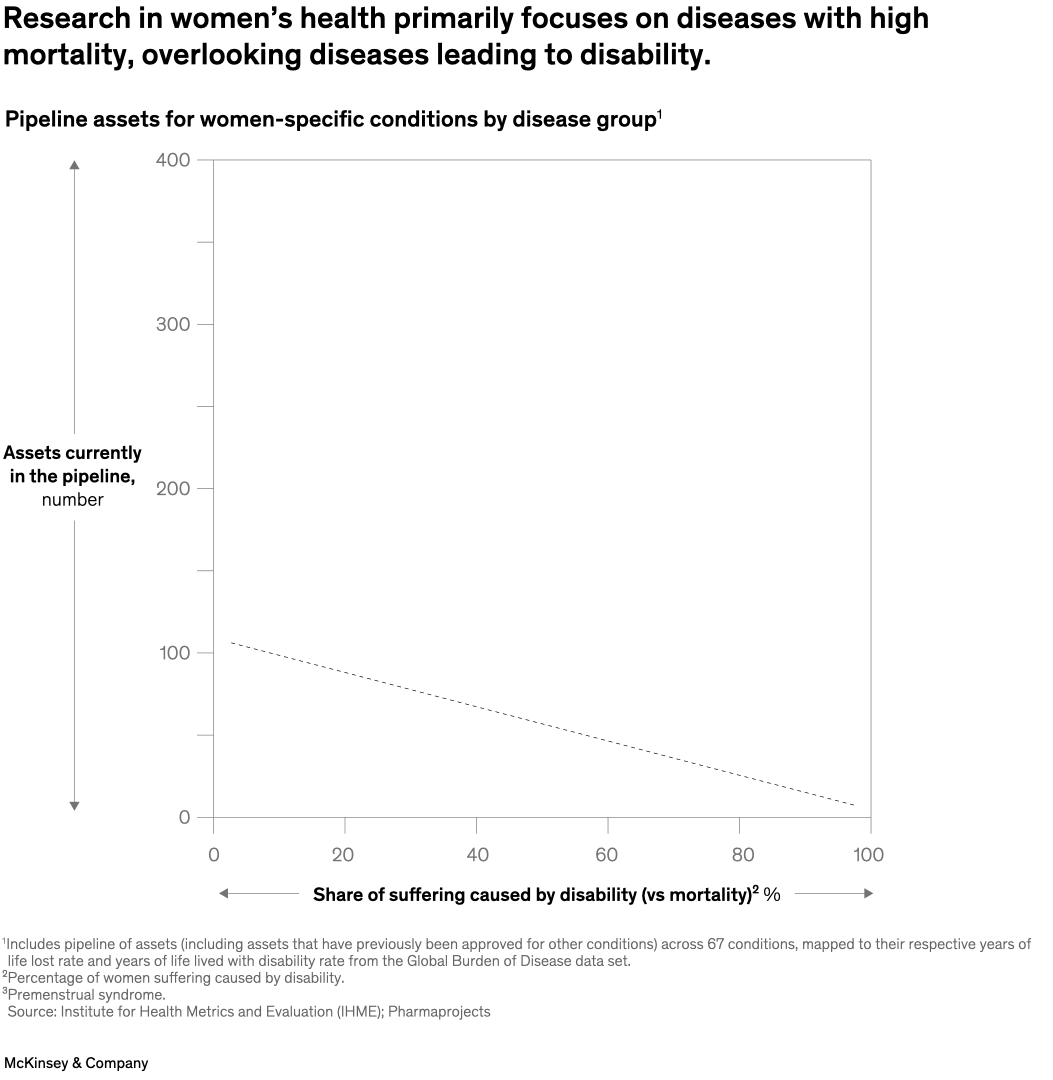
How the lack of sex- and gender-specific data and research affects safety
Since 2000, women in the United States have reported total adverse events from approved medicines 52 percent more frequently than men, and serious or fatal events 36 percent more frequently.16 Healthcare professionals in the United States reported 4.4 million serious or fatal events for women, versus 3.8 million for men through 2022.17 An analysis of all medicines withdrawn for safety reasons—a process that requires objective scientific review—shows that, since 1980, products are 3.5 times more likely to be removed because of safety risks in women patients as compared with men (Exhibit 7).
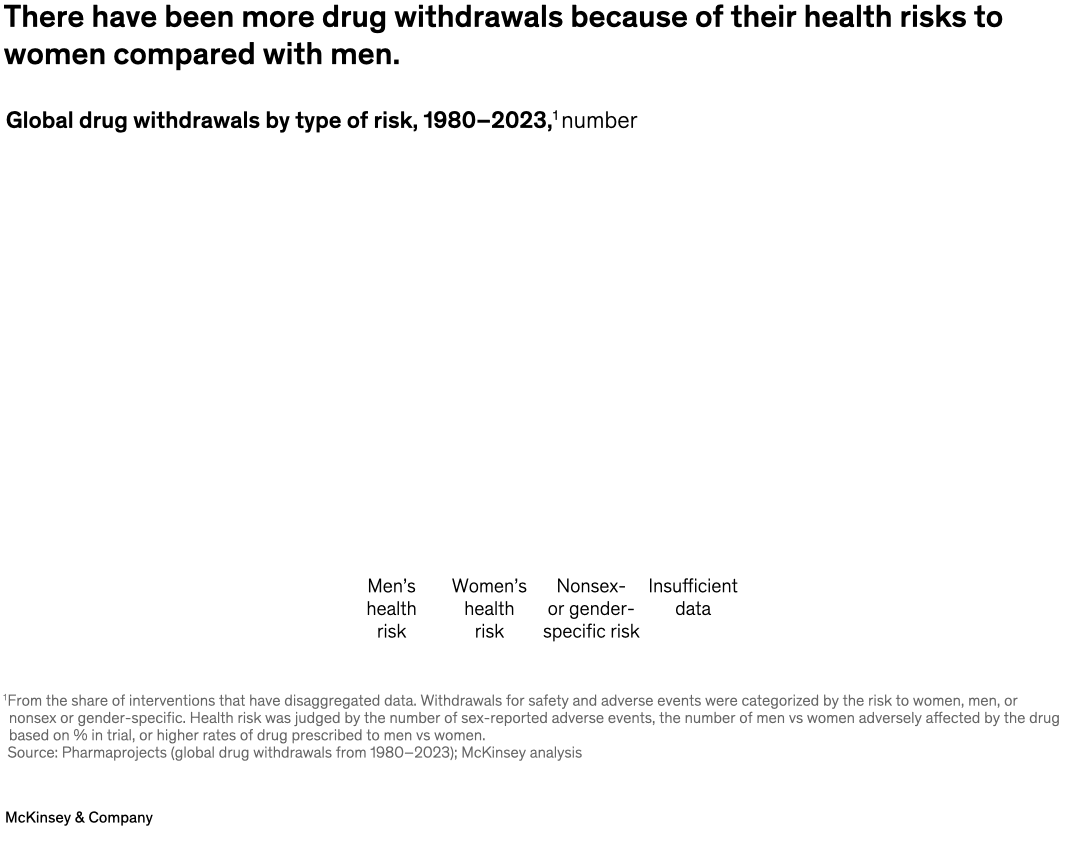
The research conducted indicates that systematic lack of disease understanding created a women’s health gap of 40 million to 45 million DALYs per year, or four days per woman per year. This is equivalent to around 60 percent of the total gap due to sex-related biology differences (see Exhibit 1 above). This estimate includes the known gap for conditions that affect both sexes and an estimate of the gap represented by the average lower effectiveness for women-specific conditions relative to men. It also includes the “unknown” gap: this is where no sex-disaggregated evidence is available for specific conditions that could, if evidence existed, potentially demonstrate levels of effectiveness difference comparable to conditions where sex-based analysis is available. The longevity of women cannot explain the disparity, and the effectiveness gap has a disproportionate impact on women and girls between ten and 40 years old and in certain regions (Latin America and Central Asia).
Shining a light on the interventions for which this information was not reported would benefit both men and women by enabling innovators to develop interventions that are better suited for specific subpopulations.
2. Data gaps underestimate women’s health burden, limiting innovation and investment
Data can quantify problems and measure the impact of potential solutions. It is the critical ingredient of robust, evidence-based analysis and decision making. Yet many of the epidemiological and clinical data sets widely used today fail to provide a complete picture of women’s health because they undercount and undervalue the health burden. When women’s health is invisible, there are missed opportunities to improve lives, especially for women and girls in vulnerable populations.18
A lack of data also leads to potential underestimation of disease severity and health burden, influencing both the care that women receive and the level of innovation and investment in women’s health. For example, an emerging body of evidence indicates potential gender bias in the measurement of pain, where women’s pain is routinely under-investigated and undertreated, with implications for clinical and psychological outcomes.19 Collectively, these incomplete data sets can influence decision making and have the potential to exacerbate the women’s health gap.
Gaps exist across the data value chain
Stage 1: Pre-data generation
The data gap starts at the very definition of women’s health. There is a lack of consistent and aligned definitions and measurement scales for conditions and symptoms affecting women. For example, definitions of health-related burden associated with menopause or menstrual syndromes differ, and pain instruments and scales lack consistency.
Stage 2: Data generation
This encompasses both epidemiological and clinical data, including the documentation of women’s specific symptoms and markers for diagnosis. There is little understanding of how some diseases manifest differently in women and a lack of data on the health-related burden associated with some women-specific conditions. For example, in the United States, 4 percent of healthcare-related R&D efforts are targeted specifically at women’s health issues.20
Stage 3: Data aggregation
Sex-disaggregated results are available in the public domain for only 50 percent of the interventions analyzed. One study found that a quarter of clinical trials in the United States had sex-disaggregated data. Further, clinical trial designs and end-point selection can fail to consider potential differences between sexes. Evidence for intervention effectiveness may be drawn from unrepresentative populations because researchers did not recruit adequate numbers of women (and minorities). In another study, in 2021, half of countries reported COVID-19 cases and deaths by sex, 14 percent reported COVID-19 hospitalizations by sex, and 10 percent reported COVID-19 intensive-care-unit admissions by sex.21
Stage 4: Data analysis
The metrics selected for analysis and publication may hide or dilute the experience of specific groups relative to others. Data sets gathered during the digital age have led to growth in machine-learning (ML) algorithms, but neither the data nor the programs applied to it are de facto neutral. Without guardrails to protect equity, this technology could perpetuate structural disparities. Artificial intelligence (AI) experts have suggested that using counterfactual fairness and similar methods can mitigate bias in areas such as race and gender.22
Women can face barriers to timely and accurate diagnosis
There is evidence of significant and systematic differences in diagnostic assessments between men and women that can affect the accuracy of calculations of the prevalence and burden for several diseases affecting women. A study conducted in Denmark23 across 21 years showed that women were diagnosed later than men for more than 700 diseases. For cancer, it took women two and a half more years to be diagnosed. For diabetes, the delay was four and a half years. Analyses of US health records and studies indicate that fewer than half of women living with endometriosis have a documented diagnosis.24
Comparisons of endometriosis estimates also indicate unexplained variations. The WHO estimates that around 10 percent of women of reproductive age are living with endometriosis.25 In contrast, the Global Burden of Disease estimates this figure to be 1 to 2 percent.26 This discrepancy—an eightfold difference—means there could be anywhere from 24 million to 190 million women affected worldwide.
For women, not only does the difficulty in getting a recorded diagnosis create a barrier to care, but the resulting lack of recorded diagnoses filters into how investors or researchers prioritize needs and assess market potential. In endometriosis, the data gap primarily reflects delays in diagnosis, which run to approximately ten years on average.27 This leads to lower research investments: for instance, adenomyosis, the sister and highly co-morbid condition to endometriosis, has received two grants from the National Institutes of Health (NIH) yet affects hundreds of millions of women across the world. In menopause, the challenge is more fundamental. While it is understood that most individuals who are biologically female experience symptoms at some point during the menopause transition,28 this is rarely counted or considered within classifications of health and disease. For example, the IHME Global Burden of Disease data set currently captures the health burden associated with menopause within a catch-all category of “other gynecological diseases.”29 As a result, it is not possible to identify clearly the underlying prevalence or the symptom severity (or disability weight) associated with menopause in that data set. Furthermore, some of the symptoms experienced during menopause, such as mood swings or depression, are often associated with other conditions, leading to misdiagnosis.30
Additionally, there is a lack of data on maternal health overall, especially in LMICs, which can lead to inadequate healthcare services for pregnant women and new mothers. The lack of data obscures the full picture of maternal health needs, making pregnancy and birth more dangerous for women and creating challenges around which interventions or policies to prioritize. The WHO reports that every day in 2020, approximately 800 women died from preventable causes related to pregnancy and childbirth. translating to a death every two minutes. Most of these deaths occur in LMICs.31
Gaps in understanding the effectiveness of health interventions
One example of the gap in clinical evaluations can be seen in US clinical trials. The Food and Drug Administration (FDA) has issued guidance on gender differences in clinical evaluation of medicines since 1993.32 In clinical trials from 2000 to 2022, women’s participation in oncology trials improved.33 However, a comparison of women’s participation with their share of the disease burden finds that women remain underrepresented in surgical trials for cancers of the bladder, head and neck, stomach, and esophagus.34 While women experience a greater share of the health burden for some diseases, such as in neurology, the ratio is not reflected in clinical trial participation. Additionally, equitable representation of women (and men) of different races and ethnicities has long lagged (see sidebar “Case study: COVID-19 vaccine development”).
Ensuring sex-differentiated results
Representative clinical studies capable of producing stratified results may involve larger and longer clinical trials, increasing costs and extending time to market. However, the results would likely lead to more effective interventions with higher uptake among patients. The risk/reward equation for investors becomes more balanced if payers (governments, insurers, and patients) and regulators insist on evidence for cohort-specific impact.
Today, some conditions, such as leukemia and meningitis, are believed to affect men and women equally. But the research to identify potential differences is lacking. Stakeholders may explore how a systematic and proactive approach to designing and reporting clinical outcomes could take sex and gender into account.
One route to start working with sex- and gender-specific data analysis in general is through meta-analytical techniques—those combining study results to draw conclusions about therapeutic effectiveness. These can be used to analyze sex-specific efficacy without increasing sample size.35 Other analysis has found that investing in women as investigators could lead to more women enrolled in trials.36
Addressing data gaps in women’s health would require concerted effort across multiple fronts,37 potentially including requiring sex- and gender-disaggregated data to further understanding.
3. Creating sex- and gender-responsive care delivery systems
Several studies have indicated that women are more frequent users of health services than men.38 These differences, however, may be reduced substantially when adjusted for different levels of need, such as reproduction or differences in disease prevalence.39 The McKinsey analysis finds that some of this unbalanced usage may result from inadequate service. Compared with men, women who present the same condition may not receive the same evidence-based care.40 These delays can add unnecessary costs to health systems, not to mention costs and stress to the patient and their family.
Inequalities exist throughout the full pathway of care
The care pathway runs from awareness of a health issue to access to services and preventive care, timely and accurate diagnosis and effective treatment and follow-up. At each segment of this pathway, inequalities exist, especially for women who are disadvantaged in ways beyond their gender (see sidebar “Intersectionality and health outcomes”).
Awareness and prevention
Health education, including menstrual education, is one of the most effective ways to help women learn about their bodies.41 Countries vary in the types and amount of health education, but around the world, women who experience conditions such as painful periods, endometriosis, polycystic ovary syndrome, or uterine fibroids may have limited awareness of what is normal and when to seek medical advice.42 Education can also improve school attendance, teach effective management strategies that reduce symptom severity, and reduce potential fertility problems in the future, which are often excluded from health insurance policies.43
Prevention and promotion are also needed for better health. The human papillomavirus (HPV) vaccine, for example, is proven to reduce the incidence of cervical cancer by nearly 90 percent, particularly if women are vaccinated when they are younger.44 In 2020, the WHO launched the 90-70-90 targets, which aim to have 90 percent of girls vaccinated against HPV, 70 percent of women screened for HPV by age 35 and again at 45, and 90 percent of women with precancer treated or with invasive cancer managed. According to the WHO, great disparities exist among countries: less than 25 percent of LICs and less than 30 percent of LMICs have introduced the vaccine, compared with 85 percent of high-income countries (HICs).45 Some 36 percent of women worldwide have been screened for cervical cancer in their lifetime—84 percent in high-income countries and less than 20 percent in LMICs or LICs.46
The importance of increasing awareness goes beyond patients. Many doctors are unaware of how diseases can affect or manifest differently in women, so they are unable to provide proper care to many patients.
Accessibility and affordability of care
Women may encounter barriers related to access and affordability. Healthcare spending and insurance premiums have historically been higher for women. For instance, in Switzerland, healthcare insurance premiums are more expensive for women because they are considered to have higher healthcare costs. On average, Swiss women pay more than 12 percent extra for supplementary hospital insurance, with greater disparities in specific age groups. A 31-year-old woman pays, on average, 37 percent more than a man of the same age.47 Similarly, Indian private insurers employ gender-based premiums, leading to higher expenses for women.48 Further McKinsey analysis of US copay rates finds American women have an average of $135 more out-of-pocket expenses per year than men. Of that, $55 goes to higher copay rates for conditions predominantly affecting women.
Affordability means more than paying for direct healthcare services; it also means being able to afford hygiene products. For instance, around 500 million people worldwide lack access to menstrual products and hygiene facilities.49 In Bangladesh, a study conducted by the HERproject showed that 73 percent of women employed by a textile factory in Bangladesh missed work for an average six days a month.50 This absenteeism negatively affects not only business but also the lives and the livelihoods of women who are not paid for days they do not work. However, when the HERproject provided menstrual pads and other work-based interventions (sharing information regarding menstruation, reducing stigma, etcetera), absenteeism dropped to 3 percent.51
Family planning also is highly relevant. Women of childbearing age who are sexually active must evaluate the cost of contraceptives, many of which are not covered by insurance. An estimated 257 million women in developing regions who want to avoid pregnancy are not using safe and effective family-planning methods, for reasons that include a lack of access and support, according to the 2023 Global Contraception Policy Atlas.52 For any woman, a lack of contraception—which can lead to sexually transmitted diseases (STDs) or unintended pregnancy—can, in the long run, result in job loss, career setbacks, diminished ability to support oneself or one’s family, and higher levels of “family dysfunction.”53
These disparities can be tackled. Alternative models and systems are helping to increase accessibility and affordability of care for women while also reducing costs for healthcare systems and individuals. Examples include the US Affordable Care Act and women’s health hubs in the United Kingdom.54
Timely diagnosis
The male-centric models of disease described earlier can contribute to delays in care and lower-quality treatment decisions once a woman is within the care system. One study found women were up to seven times more likely than men to have a heart condition misdiagnosed and be discharged during a heart attack.55 More sensitive biomarkers to detect heart attacks in women have been identified,56 and studies are ongoing to validate the impact on health outcomes, but medical school curricula and residency and fellowship trainings need to be updated to reflect these differences.
For maternal care, untreated tuberculosis may have a mortality rate of up to 40 percent in high-risk areas,57 where women often have lower uptake of treatment, probably as a result of societal norms. One possible solution is the integration of tuberculosis screening in antenatal care for pregnant women. This strategy was tested in Pakistan and proved to be feasible and effective.58
Choice of treatment
Accurate diagnosis should prompt delivery of evidence-based treatment. But sex and gender can affect care, even for common conditions. For example, upon discharge, women cardiac patients are less likely to be prescribed secondary prevention to reduce the risk of further events. This (along with other risk factors) contributes to women being twice as likely to die from a serious heart attack.59
Outcomes after an acute cardiac event could potentially improve via sex- and gender-adapted protocols for guideline-directed management. This begins at admission and continues through the procedure and until discharge. One health system reduced outcome disparities with a standardized systemwide protocol that includes emergency department catheterization lab activation, a STEMI (ST elevation myocardial infarction) safe-handoff checklist; transfer to an immediately available catheterization lab, and a radial-first approach to percutaneous coronary intervention.60 A discharge checklist for guideline-directed medical therapy has been shown to reduce mortality in heart failure patients by 65 percent for both sexes.61
While some efforts to achieve gender parity require heavy investment, there are budget-conscious solutions with potentially huge impact. UNICEF’s Côte d’Ivoire Country Office, for example, produced a low-cost version of a uterine balloon tamponade device to treat maternal hemorrhage. The product, which uses a catheter and a condom, has a 95 percent success rate and has been scaled nationally.62
Creating solutions to tackle care disparities
Overall, the gap in care delivery contributes 34 percent to the women’s health gap (see Exhibit 1 above). Consider how sex- and gender-appropriate care delivery could reduce the women’s health burden by 25 million DALYs per year globally, corresponding to 2.5 days per woman per year.
Global public health programs are increasingly being designed and improved from a sex- and gender-informed perspective. This involves an investigation of the role sex and gender play in health outcomes, including health-related stigma, barriers to accessing health services, and vulnerabilities to different health risks. For example, the Stop TB Partnership developed a gender-responsive tuberculosis delivery program and associated investment package.63 One pillar of this approach is the routine collection, analysis, and use of sex-disaggregated data and inclusion of sex and gender in monitoring and evaluation.
Improvements in the diagnostic tools available would represent a major step forward for patients. Yet even without innovative tools, it would be possible to improve care and bridge the gaps in diagnosis with more consistent and standardized screening and data collection. Earlier diagnosis and a more holistic, patient-centric treatment approach could help improve disease and symptom management, prevent uncontrolled progression and resulting complications, and reduce unnecessary treatments.
When it comes to affordability and access, counteracting the rise in healthcare costs while benefiting patients and insurance providers could be achieved through approaches such as value-based care (VBC). VBC aims to link healthcare payments to the quality of outcomes, shifting incentives for healthcare providers from performing more treatments to delivering better treatments. These models seek to enhance care quality and reduce healthcare expenses by emphasizing prevention and high-quality results.64
VBC models in the United States include accountable care organizations (ACOs), voluntary networks of healthcare providers operating under Medicare. This includes the Medicare Shared Savings Program (MSSP), which returned $1.9 billion in net savings to Medicare in 2020.65 Outside of the United States, the European Hospital Alliance’s nine hospitals have offered a blueprint that includes measuring costs and outcomes for every patient and bundled payments for care cycles.66 Value-based models are designed to reduce costs while improving quality outcomes for patients. For example, given the amount of time, number of tests, and number of providers a woman may see before an endometriosis diagnosis, a revised model of care could offer a holistic and patient-centric approach that provides a faster diagnosis, reduces costs for a healthcare system or payer, and ultimately improves outcomes.
At a global level, AI, unbiased data sets, and interoperable electronic records are potential options for enhancing care delivery. Ultimately, a combination of innovation, investment, and ability to scale could unlock better care delivery solutions for women.
4. Directing investments toward women’s health
There has been a historical underinvestment in women’s health research from the public, social, and private sectors. Funding sources typically overlook the fact that many conditions manifest differently in each sex, creating variances in outcome.
Closing the health gap will require increased investment not only for understanding sex-based differences but also for addressing unmet needs in women’s health. Further, additional funding and new business models could support sex- and gender-appropriate care.
Research funding neglects women’s health
One approach to redirecting investments is to examine policies based on actual population needs. This approach is pertinent for public funding, which continues to be one of the primary investment sources for scientific research. In the United States, up to 45 percent of basic and applied life-sciences research is funded through federal and nonfederal government sources.67 The importance of public funding is even higher if we consider that for life sciences companies to reach later-stage development, they rely on results from basic and applied research.68
Women’s health funding data by country can be scarce. In the United States, the National Institutes of Health (NIH) allocates 11 percent of its budget to women’s-health-specific research. Thus, despite women having a 50 percent higher mortality rate in the year following a heart attack, only 4.5 percent of the NIH’s budget for coronary artery disease supports women-focused research.69 In Canada and the United Kingdom, 5.9 percent of grants between 2009 and 2020 went to research that looked at female-specific outcomes or women’s health.70
In another example as of 2015, there were five times more scientific studies on erectile dysfunction than premenstrual syndrome.71 In a trial where the medication sildenafil citrate was shown to relieve menstrual pain, research stopped due to a lack of funding.72
These examples reflect how underfunding certain research leads to and augments the women’s health gap. One goal could be for existing budgets to be more fairly distributed to reflect the disease burden and unmet need. When governments and nonprofits evaluate resources and policies across populations, they create an opportunity to advance health equity and benefit society. They could consider which investments reap the highest socioeconomic return, including in medical research. One example of targeted investment is the 3not30 campaign by Women’s Health Access Matters, which aims to increase women’s health research and accelerate investment in sex-based research over the next three years.73
Many attractive opportunities in women’s health remain untapped. Currently, global life sciences R&D efforts primarily focus on conditions with a high contribution of years of life lost (YLLs) to the overall disability-adjusted life years (DALY). This has often disadvantaged women since they have a higher probability of being affected by conditions that affect quality of life—measured as years lived with a disability (YLDs)—rather than length of life. Among these conditions are rheumatoid arthritis, endometriosis, uterine fibroids, and diabetes. The disability weight for someone with moderate abdominal pain and primary infertility due to endometriosis is 0.121; for moderate rheumatoid arthritis, it is 0.3017. This translates to a person being willing to trade a year of their life to avoid 8.3 years of living with endometriosis or to trade a year of life to avoid 3.2 years with rheumatoid arthritis. Additionally, gynecological conditions, such as endometriosis and uterine fibroids, which affect up to 68 percent of women,74 have 33 assets in the pipeline , while other conditions that affect a lower percentage have more assets (Exhibit 8).
Women often face conditions that are not fatal but can cause disability and impede their quality of life.
Some conditions, such as colon or liver cancer, affect men and women differently, and on average, women are more likely to develop a more serious or severe form of these conditions.
Certain conditions, such as Alzheimer’s and other dementias, affect women disproportionately. A 2019 report found that, globally, women with dementia outnumbered men with dementia 100 to 69.1
Certain women-specific conditions, such as ovarian cancer, cause less disability because the fatality rates are higher. Ovarian cancer is the most lethal gynecological cancer, with a five-year relative survival rate of 17 percent for a patient diagnosed at an advanced stage.1
Certain conditions affecting men, such as testicular cancer, have a low number of assets and share of suffering caused by disability.
Certain conditions affect men and women equally in terms of suffering caused by disability, such as diabetes and liver disease.






Addressing sex-specific conditions can pay off. For example, the debut of Viagra for erectile dysfunction, which affected an estimated 152 million men in 1995, generated $400 million in sales revenue within its first three months in the US market in 1998.75 By 2012, worldwide sales hit a record $2.1 billion.76 Globally, given the similar prevalence and high unmet need for conditions such as endometriosis and menopause, there is enormous potential for innovative treatments (see sidebar “Market potential of treatments for endometriosis and menopause”).
Enormous potential also exists for treatment of breast cancer. There is high interest in breast cancer R&D (646 assets in the pipeline), and sales revenues from breast cancer treatments were at $18 billion in 2022 (comparatively, sales for prostate cancer treatments were $11 billion in 2022).77 An opportunity remains to improve outcomes of breast cancer in LMICs, where the fatality rate of 72 percent has been higher than the incidence rate (62 percent).78 Globally, endometriosis, uterine fibroids and menopause are among the conditions with high unmet need and economic potential.
Private equity/venture capital investors are increasing investments in women’s health, with excitement about digital health solutions
Private equity and venture capital investments in women’s health are starting to grow quickly as opportunities in women’s health become clearer and more female technology (FemTech) start-ups set out to disrupt the healthcare market.79 Within the FemTech space is concentrated activity concerning maternal health patient support, consumer menstrual products, gynecological devices, and fertility solutions.80
The start-ups making the top deals in the past four years mainly focus on men’s sexual and overall health. A McKinsey analysis found that 11 start-ups addressing erectile dysfunction, among other men’s health concerns, secured $1.24 billion in 2019–23, while eight start-ups addressing endometriosis received $44 million. Funding for companies focusing on erectile dysfunction was six times greater than for companies focused on endometriosis. However, investors may be starting to see the potential. In the past four years, women’s health newcomers received $2.2 billion in funding. Some 60 percent of the top deals exclusively addressed women’s health, specifically endometriosis, fertility, and maternal and neonatal health.81
Another potential avenue for innovation is digital health, which has the potential to make health more equitable.82 In the digital healthcare space, FemTech companies received 3 percent of the total digital-health funding.83
Given the large unmet need and resulting opportunity, those who continue to forgo investing in women’s health may find themselves left behind by the players that tap into this high-potential market.
5. Closing the gap in women’s health could boost the global economy
The disparities in women’s health affect not only women’s quality of life but also their economic participation and ability to earn a living for themselves and their families. Health is intricately linked to economic productivity, prospects for prosperity, and contribution to economic output. Economic growth over the past 70 years has been closely tied to women’s increased labor force participation. Therefore, it is not surprising that the gap in women’s health results in lost economic potential.
Addressing the health gap women face could boost the global economy by adding at least $1 trillion to the global economy by 2040. This means a 1.7 percent increase in the average per capita GDP generated by women.
Women’s economic participation has been and will be a major driver of economic growth
Extended participation by women boosts economies and GDP growth.84 The rise in the number of women in formal economic activities since the 1950s has been a major driver of economic growth and wage increases.85 Ability to participate in the economy also benefits women individually. In a 2023 poll, when women around the world were asked if they preferred to work in paid jobs, care for their families, or do both, 70 percent said they preferred to work in paid jobs or do both.86
Conversely, the women’s health gap limits individual women and directly affects the global economy by impairing women’s economic participation and productivity. Chronic diseases are often linked to extended absences from work,87 and poor health is a cause of “presenteeism,” where individuals go to work but cannot perform at their full capacity, reducing productivity. Finally, disabilities and informal caregiving obligations hold back affected individuals, often women, from full workforce participation (see sidebar “Endometriosis and menopause have a substantial impact on women’s ability to work and earning potential”).
Addressing the gap could generate the equivalent impact of 137 million women accessing full-time positions by 2040. This would enable women to secure an income to support themselves and their families and has the potential to lift more women out of poverty.
Better health often enables individuals to work more effectively
The health disparities outlined in this report affect individuals of all age groups, with about 50 percent of the burden affecting women of working age. Closing the women’s health gap could allow women to add 1.7 percent to GDP . Comparatively, the World Bank estimates that if the status quo remained, GDP growth could reach 2.7 percent, 2.9 percent, and 3.4 percent in 2023, 2024, and 2025, respectively.88
Looking at the different channels affecting GDP, the largest impact, amounting to around $400 billion or avoiding 24 million years with disability, would be created through fewer health conditions (Exhibit 9). Expanded participation and increased productivity could each contribute more than 20 percent of total impact.
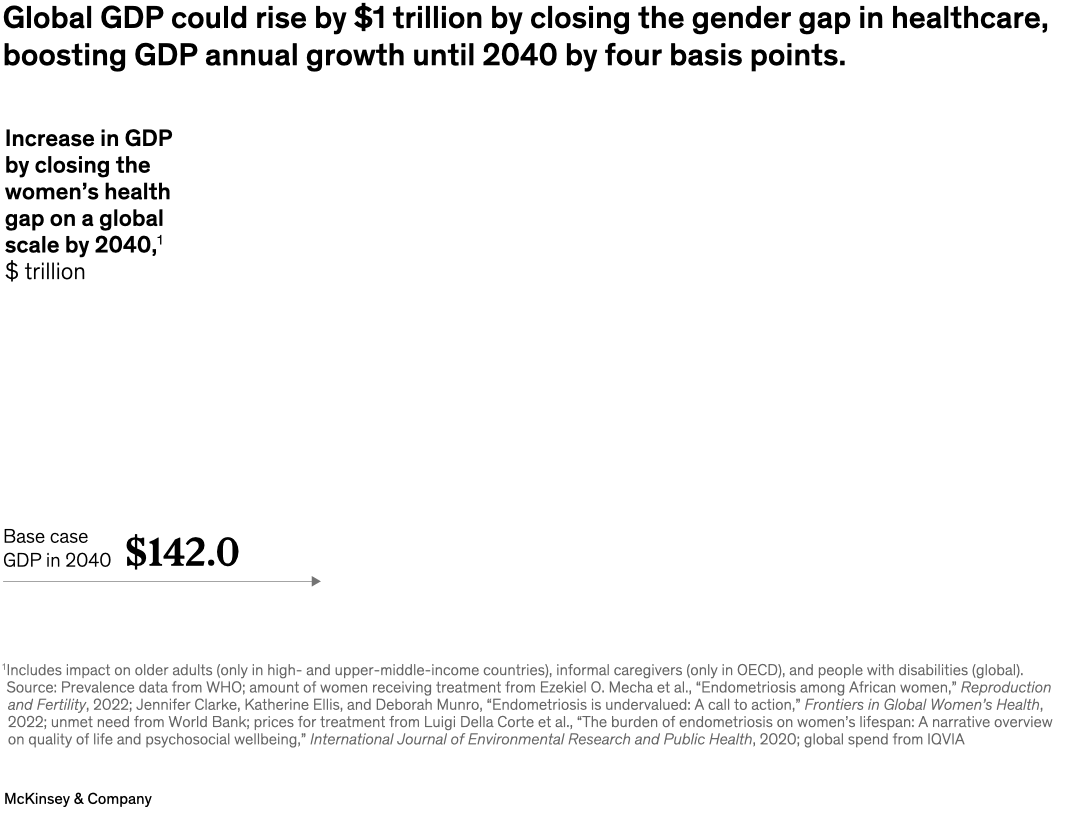
Treating ten health conditions would contribute more than half of the economic impact
On a global level, effective treatment of ten conditions—for example, premenstrual syndrome (PMS), depressive symptoms, and migraines—could make up more than 50 percent of the economic impact (Exhibit 10). This impact suggests which conditions to consider prioritizing globally. For example, addressing PMS has the potential to contribute $115 billion to the global economy. Rather than defaulting to PMS being a “part of life,” there are ways to manage symptoms. A 2020 analysis found that women who took calcium supplements experienced fewer PMS symptoms, such as anxiety or water retention, than women who took a placebo.89 A study in Iran found that the severity and frequency of PMS symptoms was significantly lower in an intervention group that offered education and coping strategies.90 Addressing PMS with effective interventions could allow women to experience less pain, experience better quality of life, and feel more able to work.
The conditions having the greatest economic impact in different countries will differ from one geographic region to another based on each region’s disease burden and healthcare status. The examination of economic impact, rather than DALY impact, gives more weight to conditions that affect people during years of working age, as that is when economic contribution is highest. Conditions such as ischemic heart disease may affect more people, but if the burden of morbidity and premature mortality happens after the usual age of retirement, the economic impact is more limited.
Additionally, other conditions not listed could be the underlying cause for the top ten conditions. For example, infertility can lead to significant anxiety, depression symptoms, and other psychological distress.91
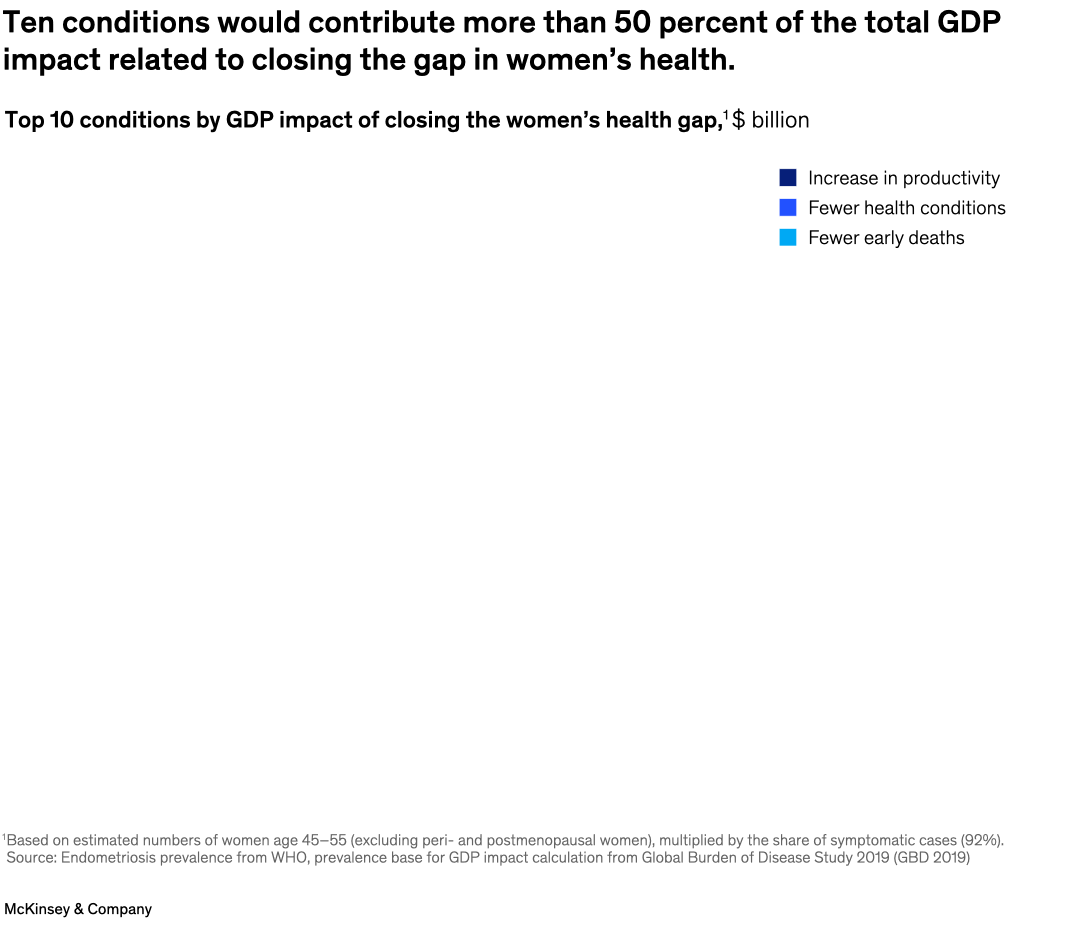
Generally, a reduction in health conditions is tied to a woman’s economic potential, with allowances for regional socioeconomic and healthcare factors (Exhibit 11). The top two conditions by contribution to GDP impact of the women’s health gap are always a combination of two of the top four global conditions: PMS, depression, migraine, or other gynecological conditions. Larger differences among regions are observed when looking at the top ten or more conditions.
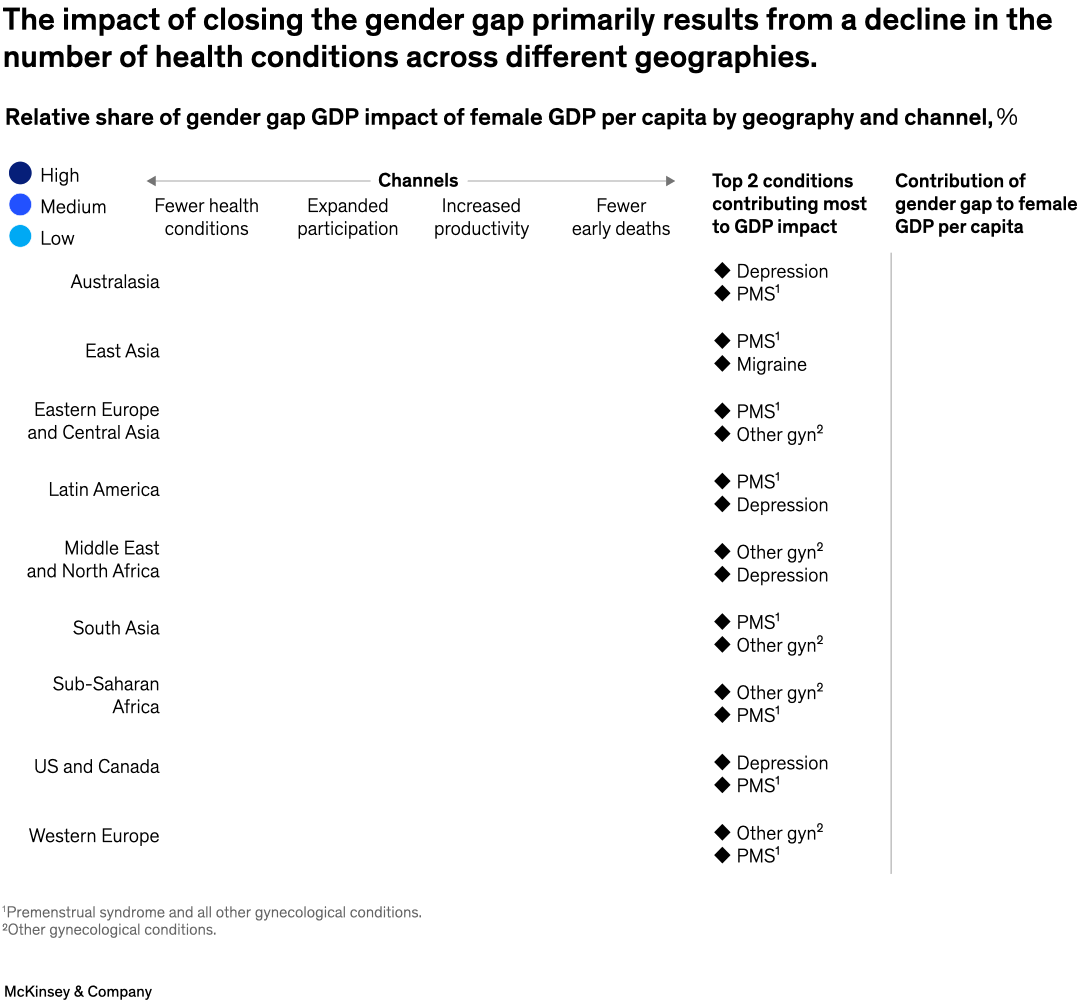
Across the four channels, the highest GDP impact relative to women’s GDP is observed in HICs and LICs (Exhibit 12). For LICs, most of the impact comes from fewer early deaths and fewer health conditions. Both upper-middle-income (UMIC) and lower-middle-income (LMIC) regions exhibit an overall lower projected GDP impact.
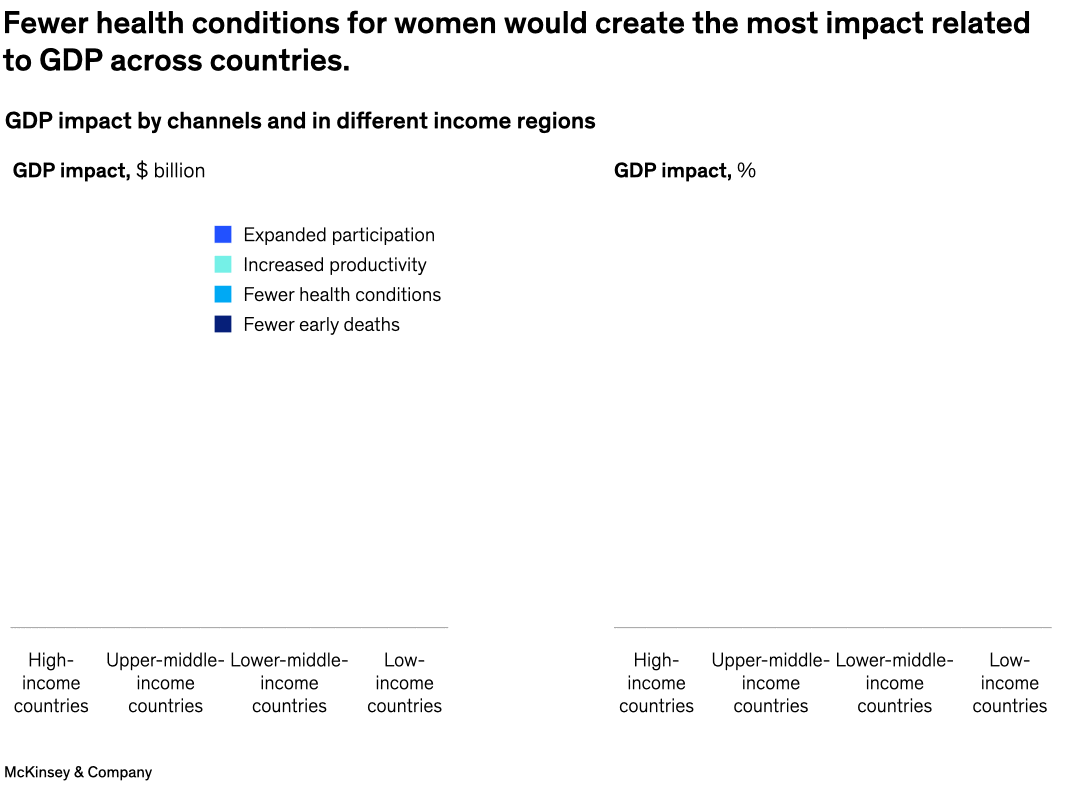
Investing in women’s health shows positive return on investment (ROI): for every $1 invested, approximately $3 is projected in economic growth
Investing in improving women’s health not only improves women’s quality of life but also enables them to participate more actively in the workforce and make a living. The potential value created through women’s higher economic participation and productivity exceeds the costs of implementation by a ratio of $3 to $1 globally. This estimate is based on the net annual costs associated with the additional uptake of interventions required to address the women’s health gap, including all relevant interventions considered cost-effective in each setting.92 The analysis compared this to the additional economic potential that could be unlocked by the health improvements associated with these interventions.
The expected economic return varies by region. The ROI is greatest in higher-income settings, where it is around $3.50 returned for every $1 invested. More investment is probably needed in some LICs to establish the basic health infrastructure required to support low-cost delivery of high-quality health services, as well as to create better and more rewarding economic opportunities for women. Still, the analysis indicates that the overall benefit would exceed the costs even in these settings, at a rate of around $2 returned on $1 invested.
The analysis examines only the direct costs of addressing the gaps in care delivery identified. In the longer term, a range of greater positive returns is possible, given that improvement in the lives of women influences the health and resilience of their families and communities.
Where to start tackling the women’s health gap to reap the greatest benefit for all
Globally, the top ten conditions by economic impact account for more than 50 percent of the total GDP impact. This highlights areas with high unmet needs and potential, aiding decision makers in prioritizing efforts to address health disparities. Specific conditions and their socioeconomic contexts vary among regions, influencing their contribution to the economy. This information could guide tailored strategies toward health equity.
The content and sequence of each action will need to be tailored to regional conditions. Building on the knowledge developed throughout this report, a fact-based strategic assessment can lead to better health equity for each country.
6. Call to action: How to close the women’s health gap
As noted in this report, women’s health has been under-researched, and women face different challenges from men in affordability and access to treatment. This health gap creates unnecessary suffering and preventable economic losses.
It does not have to be this way. Through collaborative efforts on five fronts, a more equitable and healthy future is possible. There is an opportunity to close the women’s health gap by (1) investing in women-centric R&D, (2) strengthening the collection and analysis of sex- and gender-disaggregated data, (3) enhancing access to gender-specific care, (4) encouraging investments in women’s health innovation, and (5) examining business policies to support women.
Invest in women-centric research to fill the knowledge and data gaps in women-specific conditions, as well as in diseases affecting women differently and/or disproportionately
The women’s health gap could be narrowed by increasing funding to achieve equality with investments in funding for men’s health and using protocols that set standards of equity and diversity. Scientists, life science companies (pharma, biotech, medtech), healthcare providers, and others in the healthcare ecosystem may consider how the traditional understanding of disease is focused primarily on the male body. A more in-depth understanding of these differences would enable more effective care interventions and improved health outcomes. One example of venture-capital-backed funding addressing this disparity is Repro Grants, which allots up to $100,000 for research projects aimed at deepening understanding of female reproductive biology.
For conditions that affect women differently or disproportionately, more effective interventions start with clinical trials designed with inclusivity at their core, informed by preclinical research using female animal models. Specifically, there should be stronger diversity, equity, and inclusion guidelines for clinical trial design. Guidance could incorporate male versus female disease prevalence mix and use sex-specific thresholds for biomarkers to yield an adequate patient representation in clinical trials.
Equitable representation by prevalence also implies more diverse research organizations. Life science companies, academic institutions, and educational bodies should ensure that women and people of color not only find representation but be actively involved in research, leadership, and decision-making roles. For example, women form almost 70 percent of the global health and social workforce, but it is estimated they hold only 25 percent of senior roles.93 The benefits of increasing women’s representation are manifold: for example, teams boasting diverse gender representation have been associated with higher levels of accountability and effectiveness.94 In one study that analyzed more than 440,000 medical patents filed from 1976 through to 2010, patented biomedical inventions created by women were up to 35 percent more likely to benefit women’s health than biomedical inventions created by men. The patents from women were more likely to address women-specific conditions such as breast cancer and postpartum preeclampsia, as well as conditions that disproportionately affect women, such as lupus.95
Systematically collect and analyze sex-, ethnicity-, and gender-specific data to have more accurate representation of women’s health burden and the impact of different interventions
The prevalence of conditions such as endometriosis and menopause is underestimated, leading investors and life science companies to underestimate the market potential of these conditions and underinvest. By accurately assessing and reporting on the prevalence of such conditions, national health institutes and other authorities may direct additional funding to the research and treatment of these underserved conditions.
- Beyond epidemiological data, today’s technology makes the systematic collection and analysis of sex-, race-, and gender-disaggregated data simpler at all stages of the R&D process. Life science companies could harness this capability to strengthen the collection, analysis, and reporting of disaggregated data at each stage of the process. This approach to data has the potential to enable life sciences companies to evaluate the safety and efficacy of their pipeline products more accurately, including by adjusting formulations and dosages. This could yield better health outcomes and a higher probability of success. To further encourage the shift toward disaggregated data, the Women’s Health Innovation Opportunity Map 2023 proposes establishing sex as a biological variable.96 This would enable national health departments and international health organizations to develop and enforce guidelines regarding disaggregation of data by sex and gender in research studies and health surveys.
- Biotech, medtech, and FemTech enterprises also have exciting opportunities related to AI and ML, which ensures that these models do not exacerbate existing biases or violate patient privacy rules. Developing robust, secure, and holistic data sets could enable companies to differentiate in an overcrowded marketplace.
Enhance access to gender-specific care, from prevention to diagnosis and treatment
- Women deserve the same high-quality level of care from their healthcare providers as men, which doesn’t mean the same care per se. There is a pressing need to redesign medical curricula as well as residency and fellowships to reflect sex and gender differences. In addition to medical schools, continuing medical education organizations and credentialing entities could assess whether healthcare providers are receiving the latest information and training on the women’s health gap and sex- and gender-based differences. Current and future healthcare professionals of all specialties must be equipped with accurate and updated knowledge of biological differences, including sex-specific manifestations of symptoms. Future certification or tests could include questions meant to address whether providers have internalized this knowledge.
- Next, the path to excellence in clinical care lies in acknowledging and rectifying inherent equity disparities. Gender- and sex-responsive services benefit patients, healthcare providers, and society at large. Health systems could implement new guidelines and protocols (for example, sex-specific cutoffs for biomarkers, discharge checklists) to guide decision making and minimize biases. Similarly, life science companies could include sex-specific evidence and outcomes on product package inserts and labels to inform healthcare professionals on the best regimens for different subpopulations.97
- To reduce maternal mortality globally, investing in the training and upskilling of midwives could save an estimated 4.3 million lives per year and prevent roughly two-thirds of maternal deaths, 64 percent of newborn deaths, and 65 percent of stillbirths while contributing to the economic development and empowerment of women.98
- Governments, educational bodies, philanthropic institutions, and many other stakeholders can use this moment to raise awareness of the sex-specific manifestations of disease—for example, ensuring that newly diagnosed endometriosis patients have access to up-to-date resources, including which trials they could potentially participate in. Healthcare entities, philanthropic organizations, or community health workers could start or reinvigorate in-person support groups for conditions such as endometriosis or menopause or for mental health support. Collectively, better education and resources, plus new diagnostics, are among the ways to potentially elevate the quality of healthcare women receive.
In addition, two things to enable closing the gap include:
Create incentives for new financing models to close the women’s health gap
- Historically, given lower levers of investments overall for women’s health under the traditional financing model schemes, new financing models have a critical role to play. These models can accelerate innovation. One example is the advance market commitment (AMC) geared to COVID-19 vaccine development and deployment.
- Research and reliable data on the women’s health landscape can help spur investment. For investors, the gender-based healthcare landscape presents a mosaic of unexplored opportunities. By pivoting toward this opportunity, investors can channel funds into high-impact areas, bridge the data gap, and enable more investment and innovation.
- Governments could explore policies that encourage sex- and gender-responsive health research and services—for example, by earmarking funds, providing tax incentives, lowering application fees, and expediting the drug approval process. Philanthropic organizations, donors, and international bodies could offer grants and prizes at a national or local level to spur innovation while supporting capacity building in regions where gender-based health disparities are highest. Examples might be launching a grant or award program geared toward reducing rates of respiratory illnesses in areas where there is a high percentage of women smokers, or toward a technology-based solution for women in vulnerable populations to access transportation to healthcare services.
- Private-sector stakeholders could help develop new financial products and investment vehicles, such as gender-lens investing, to attract capital to projects that directly address the women’s health gap. Governments could further promote private-sector investments by creating tax incentive programs for angel investors and venture capitalists that invest in women’s health.99
- With collaboration, stakeholders have the potential to encourage investments and inspire the development of innovative financing models in women’s health.
Establish business policies that support women’s health
As previously outlined, healthcare disparities also lead to economic losses due to absenteeism, presenteeism, and reduced productivity overall. Employers could consider how their workplace policies and benefits support women’s health, examine ways to better involve women in decision-making processes, provide health and wellness benefits that support women’s health, and create safe working environments in which women can speak openly about their health needs. By better understanding employee demographics, employers could invest in the areas with higher impact and potential. For example, if a workforce includes women between 45 and 55 years old, high impact could come from flexible work policies that recognize menopause. Given the fact that women are more than twice as likely as men to have depressive symptoms in their lifetime,100 employers may explore how mental-health programs can help employees find evidence-based mental health resources that meet their needs.
Often, leaders create change in the workplace based on their own experiences, knowledge, or vision. If the decision makers are predominantly men, the workplace tends to benefit men. Previous McKinsey research has found a “broken rung” in women’s advancement throughout industries: for every 100 men promoted from entry-level to manager roles, 87 women are promoted and only 73 women of color are promoted.101 Overall, due to gender disparities in early promotions, men end up with 60 percent of manager-level positions in a typical company. More women in senior leadership positions may be able to advocate for policies that support women’s health, and companies may ultimately benefit from a healthier and more productive workforce.
Data-driven, scalable actions to improve women’s health may vary widely, but the critical component is to determine how each stakeholder can contribute to narrowing the gap.
Conclusion
If health equity efforts sit within a tree of principles, they can be watered by research, flourish in the sun of business investments, and grow far-reaching branches that stretch into the economy.
Achieving health equity is a collaborative and ongoing endeavor that relies on the active participation of governments, healthcare institutions, nongovernmental organizations, individuals, and all stakeholders vested in this cause. Tackling the women’s health gap depends on addressing the interconnected factors outlined in this report: the deficit of women-specific knowledge in science, the glaring data gaps, the disparities in healthcare delivery, and the insufficient investment in women’s health.
Recognizing the vast potential to improve the lives and livelihoods of half the global population while boosting the economy serves as the catalyst for closing the women’s health gap. Every facet of this gap, from limited education to suboptimal treatments, offers an opportunity for transformation with the active involvement of governments, life science innovators, educational institutions, philanthropists, activists, and more.
In this endeavor lies an opportunity of $1 trillion in economic potential driven by improved women’s health and economic participation. The question is not whether this wealth of opportunities exists but rather who will take the initiative to seize it and drive change.
Women’s health is not a stand-alone issue; it is a cornerstone of societal well-being and progress. Better health and well-being for women creates a ripple effect that extends to families, communities, and nations. This holistic approach, supported by collective action and sustained investment, will not only narrow the health gap but also contribute to the betterment of a shared global future.
